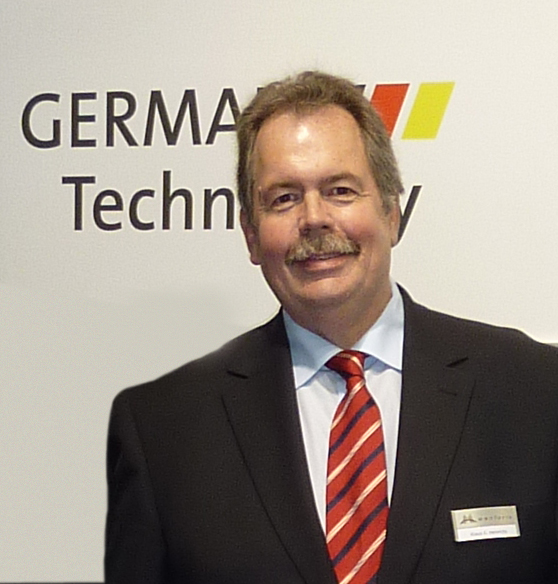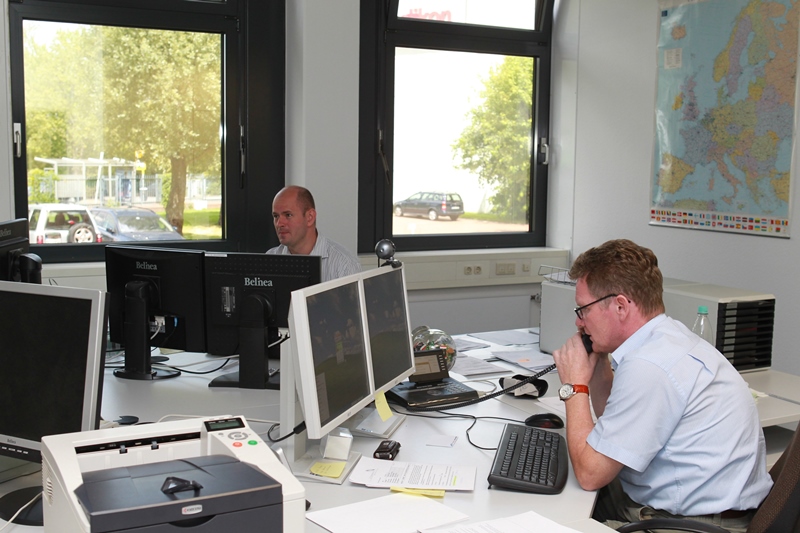The nature and number of the technological challenges which manufacturers of stenter frames for textile finishing are expected to meet are growing constantly. Monforts, a Mönchengladbach-based company, and member of the Fong‘s Industries Group (Hongkong) since 2013, intends to point the way forward at the ITMA textile machinery trade fair this autumn. Company Vice President, Mr. Klaus A. Heinrichs answers questions on customer service and new markets.
Of-the-peg technology will and must continue to exist, but special requirements are becoming noticeably more prevalent…
Absolutely. This applies not only for a constant stream of new coating “recipes” for clothing, but also for the high standards expected of the equipment for technical textiles. Two examples, the largest manufacturer of denim (jeans fabrics) in the world, a Turkish company, has bought five extremely complex special systems from us and a Chinese firm that supplies the high-tech shells for the spacesuits worn by Chinese Taikonauts, uses Monforts machines to coat the materials.
What can we expect at the ITMA, the global showcase for textile machinery, from Monforts, a leading manufacturer of stenter frames and Continuous Dyeing Ranges?
Monforts will present several new solutions for coating technical textiles. Since air pollution control is a very important issue in many Asian countries, for example, Monforts will be exhibiting modular equipment for cleaning exhaust air and preventing odour emissions from textile machinery. Since Monforts has very extensive expertise in the field of denim equipment, in Milan, in November, we are also going to unveil a combination system for stretching and compressive shrinking fabrics of this kind.
Innovations that the engineers from Mönchengladbach have pioneered?
That has always been the case, although since recently research and development projects are being conducted at our Technology Centre. The equipment available there includes not only laboratory facilities but also dyeing, coating and stenter frame systems for knitted goods with actual working widths up to 2.2 m. It is not only our developers who use this equipment, customers too, such as Dupont and 3M not long ago, or others from Portugal, Pakistan, Bangladesh and Colombia of the USA, conduct their own experiments here and can see the results of textile finishing in real time.
And textile researchers from closer to home are also welcome?
Yes. Some coating projects are being run jointly with the Lower Rhine University of Applied Sciences, specifically with the Research Institute for Textiles and Clothing. This cooperation has evolved over a considerable period. We welcome textile engineers while they are studying and after they qualify. One recent graduate completed her work experience semester with us and we have just hired her as a project engineer. Our employee roster includes a number of graduates from the Lower Rhine University who have secure employment with us.
Your production is carried out in Austria since 33 years. A few years ago you opened a further production site in Zhongshan in China. What was the historical context for this further new production site?
We evolved from a large family enterprise, but in the 1990s, after the fourth generation, the question of succession proved impossible to solve. Since we had already been running a joint venture with the Hong Kong-based Fong‘s Industries Group for many years even then, after an intermediate stage our Chinese partners took the company over in 2013. Monforts still has a German management board. Our Chinese corporate managers visit Mönchengladbach several times a year, as this is where all of the research and development for the Fong‘s Group is carried out, on behalf of coating technology, continuous dyeing and finishing. A further positive effect is the new Technology Centre.
A question for the fiscal expert: Where does a company with such a structure pay its taxes?
In Germany, incidentally for our Austrian production company Montex as well. We build the stenter frame systems, particularly those with the most frequently requested working widths in our ultramodern factory in China, stenter frames and everything that is more specialised and tends towards technical textiles, for example, is produced in Austria. Of course, the same quality standards apply to all of our facilities, but our customers are never in any doubt as to where their machines are made.
You employ a number of engineers to service Monforts equipment worldwide as part of a teleservice arrangement. What benefits does this bring?
For the customer it is a direct monetary benefit if it means that machines are installed and commissioned sooner, and in the event of standstill during production, downtimes are minimised. The consequences of a stenter frame system malfunctioning in coating are considerably more serious than if one of 60 looms is out of service. For this reason, up to four experts in Mönchengladbach are in contact with our customers all over the world from 7 o’ clock in the morning until 7 o’ clock in the evening. When our workday is over, a Monforts employee in Asia takes over the shift.
What is so special about the Monforts remote service? It is no secret that your competitors don’t sleep.
For years, all new machines have been shipped with a TÜV-tested teleservice gate to the help desk installed in the machine. If the customer opens the gate, we can provide preventative maintenance and we can also tell if the drive units are overloaded or if malfunctions have occurred, for example. We then make the system operator aware of the fault via webcam. In terms of teleservice depth, we have, shall we say, the edge over our competitors. We can also download software updates to a given system via the teleservice facility. This means that in most cases the customer service technician is spared a trip to the site, which is tedious and expensive for the customer. Wearing and spare parts for the given system as stored in the teleservice software and the customer can identify them easily and order them simply and securely.
What benefits does a midsize company derive from its membership in an organization like the VDMA?
Monforts as a company is actively involved in various committees of the VDMA through several of our senior personnel (Managing Director, chief technologist and Vice President). The benefits to us include not only the trade fairs and exhibitions or foreign business consulting opportunities, but also access to new markets. For example, we have taken part in study trips to learn about areas that still represent unexplored territory for us, such as Vietnam and Ethiopia. In Iran, the VDMA succeeded in organising an extremely well attended symposium for existing and new Iranian customers from the textile industry long before the visit by the Economic Affairs Minister. I attended this myself and was able to see at first hand the immense technological gap between ourselves and the local textile industry. As part of our after-sales care, we had also used the event to send a customer service technician to our long-standing Iranian customers. A free technology check is very much welcome in this industry. As a charter member of the Textile Machinery division, Monforts also enjoys the image advantages of the VDMA’s bluECOmpetence campaign and thus publicly declares its efforts to implement technology for the sustainable reduction of energy consumption and resource conservation.
“The VDMA benefits to us include not only the trade fairs and exhibitions or foreign business consulting opportunities, but also access to new markets” says Mr. Heinrichs.

